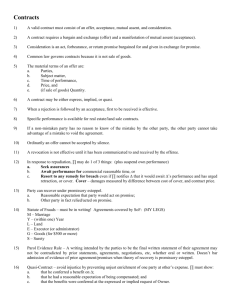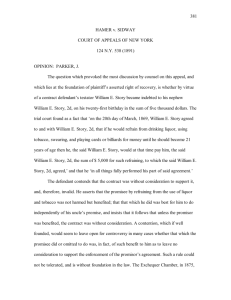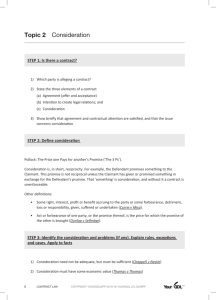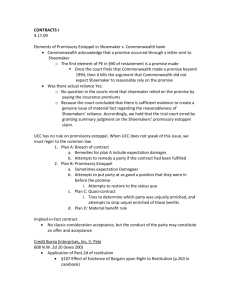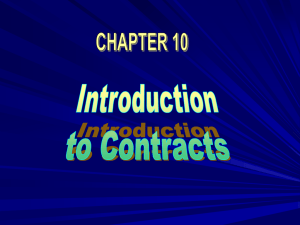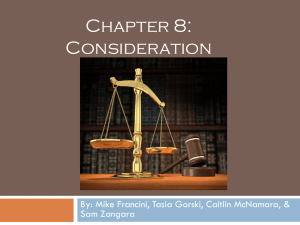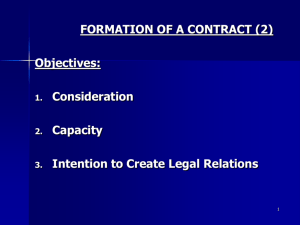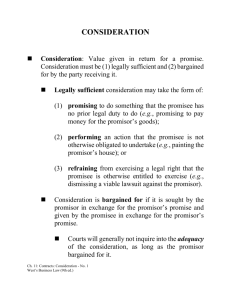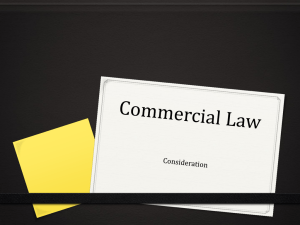Bakan_Law_110_-_Contracts_Fall_2013_Rachel_Lehman
advertisement
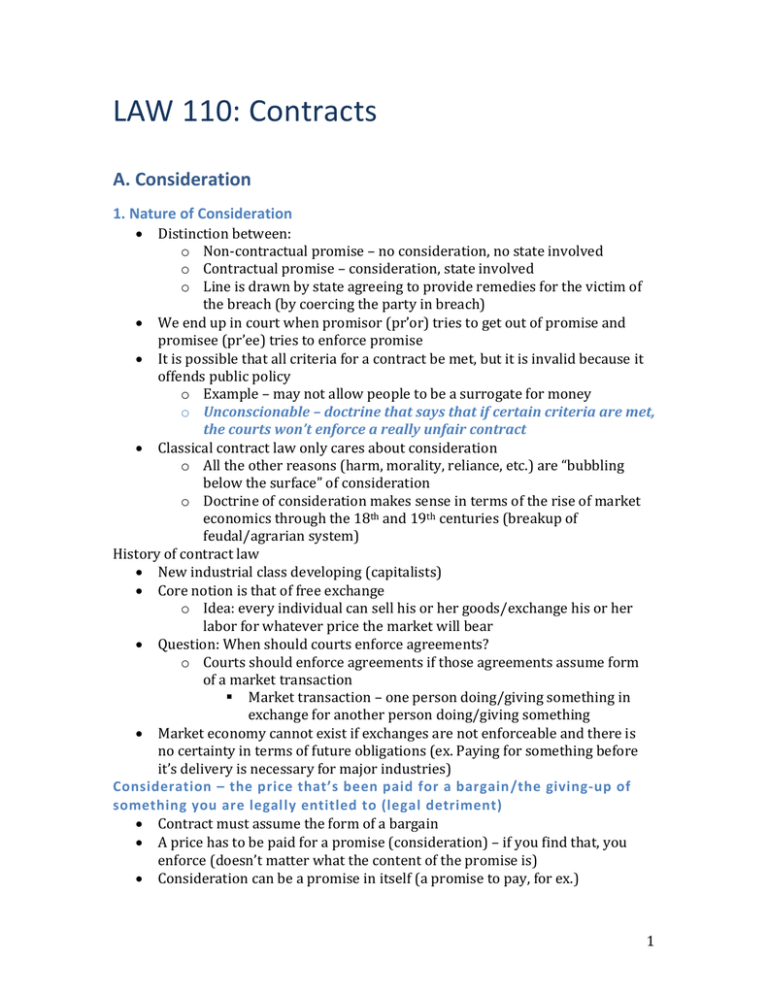
LAW 110: Contracts A. Consideration 1. Nature of Consideration Distinction between: o Non-contractual promise – no consideration, no state involved o Contractual promise – consideration, state involved o Line is drawn by state agreeing to provide remedies for the victim of the breach (by coercing the party in breach) We end up in court when promisor (pr’or) tries to get out of promise and promisee (pr’ee) tries to enforce promise It is possible that all criteria for a contract be met, but it is invalid because it offends public policy o Example – may not allow people to be a surrogate for money o Unconscionable – doctrine that says that if certain criteria are met, the courts won’t enforce a really unfair contract Classical contract law only cares about consideration o All the other reasons (harm, morality, reliance, etc.) are “bubbling below the surface” of consideration o Doctrine of consideration makes sense in terms of the rise of market economics through the 18th and 19th centuries (breakup of feudal/agrarian system) History of contract law New industrial class developing (capitalists) Core notion is that of free exchange o Idea: every individual can sell his or her goods/exchange his or her labor for whatever price the market will bear Question: When should courts enforce agreements? o Courts should enforce agreements if those agreements assume form of a market transaction Market transaction – one person doing/giving something in exchange for another person doing/giving something Market economy cannot exist if exchanges are not enforceable and there is no certainty in terms of future obligations (ex. Paying for something before it’s delivery is necessary for major industries) Consideration – the price that’s been paid for a bargain /the giving-up of something you are legally entitled to (legal detriment) Contract must assume the form of a bargain A price has to be paid for a promise (consideration) – if you find that, you enforce (doesn’t matter what the content of the promise is) Consideration can be a promise in itself (a promise to pay, for ex.) 1 Does not have to be an actual benefit to pr’or or an actual detriment to pr’ee Equivalency between what pr’or gives in exchange for what pr’ee gives is not necessary Three ways to incur legal detriment: 1. Giving a tangible thing (money, property, etc.) that you own or promising to give a tangible thing that you own 2. Doing something that you are not legally required to do (work, etc.) 3. Refraining from doing something that you are legally entitled to do The price that’s paid for a promise must be what was requested by pr’or Thomas v Thomas Facts – John Thomas died and appointed Benjamin and Samuel Thomas (his brothers) to take possession of his property. Before he died John said he wanted wife (Eleanor) to have the house or get 100l. Brothers consented to this and said Eleanor could live in house for her lifetime if she paid 1l/year and kept dwelling in good repair. Samuel died and Benjamin attempts to kick Eleanor out of house. Eleanor launched legal action to enforce contractual promise. Defendant – Benjamin Thomas (brother) Plaintiff – Eleanor Thomas (wife) Who won? Plaintiff Issue – What constitutes consideration? Holding – Eleanor can remain living in the house because the 1l ground rent (and possibly the liability to repair) serves as consideration for the brothers’ promise. Ratio – Consideration is something of value in the eye of the law moving from pr’ee to pr’or. Consideration does not have to matter in real terms (it can be nominal). Reasoning – The moral argument that the wishes of the testator should be respected is irrelevant (“motive is not the same thing as consideration”). The 1l rent is consideration because it is something of value in the eye of the law. 2 2. Past Consideration B gives something to A, A promises to give something to B in return o Is what B gave to A consideration? o Example – B swims out to rescue A, once A is on the beach he says he is so grateful he will give B his car. Is B’s rescue consideration for the car? Element of request can’t exist here that’s the problem o B’s act is not consideration because he did it before A’s promise The real issue here is request o If someone does something without having been requested to do that, and then someone in gratitude promises they will give them something, that promise is not binding Eastwood v Kenyon Facts – Sarah (Kenyon’s wife) was left as sole heiress of Sutcliffe. Eastwood, Sarah’s former guardian, spent money on her education and for the benefit of her estate and for this purpose borrowed money from Blackburn (and gave him a promissory note). Sarah promised to pay note and did pay one year’s interest. Kenyon promised Eastwood that he would pay the amount of the note after marrying Sarah. D failed to make any payments. Eastwood sued Kenyon on his promise. Defendant – Kenyon (Sarah’s husband) Plaintiff – Eastwood (Sarah’s former guardian) Who won? Defendant Issue – Can the money Eastwood spent on Sarah’s education be considered consideration for Kenyon’s promise to pay amount of note? Holding – Kenyon’s promise cannot be enforced for want of consideration. Ratio – A request must precede consideration for the consideration to be valid. Reasoning – If this promise was enforced, people would start voluntarily doing things and then claiming repayment and legal requirements would be created even when the receiver didn’t want was given to them. Sarah never requested the money Eastwood spent (and Kenyon definitely didn’t request the money), but if there had been a request this could have carried over to Kenyon. If money had been spent on necessaries, a request from Sarah could have been implied. Lampleigh v Brathwait Facts – Brathwait murdered a man and asked Lampleigh to travel to get a pardon from the King. Lampleigh traveled (at his own expense) to try to get the pardon. When Lampleigh returned, Brathwait said that he would pay for his travel costs. Lampleigh sued Brathwait for the money he spent traveling. 3 Defendant – Brathwait (murderer) Plaintiff – Lampleigh (traveler) Who won? Lampleigh Issue – Is Brathwait’s promise enforceable, even though it was made after the consideration was given by Lampleigh? Holding – Brathwait’s promise can be enforced because it was a ratification of the deal that was made before the consideration was given. Ratio – If A does something for B at B’s request, and B later ratifies his request (by saying he will pay A, for example), B’s ratification is binding. If (a) there is a request and (b) the requestor implies there will be remuneration, a later promise ratifying the request can be enforced. Reasoning – An initial request implied that there will be some remuneration later, and the money offered after the consideration is given becomes that ratification. 4 3. Pre-existing Legal Duty If you’re doing the same thing you have already contractually agreed to do, you are not giving up a legal detriment In this area, clash between practicalities of doing business (sometimes the easiest thing to do is pay more for something you have a contract to pay less for) and the doctrine of consideration Ways to get around this: o Invoke Williams v Roffey o Argue that the parties effectively terminated existing agreement and created a new one Stilk v Myrick/Gilbert Steel Stilk v Myrick Facts – Seaman was paid 5 l/month on a voyage. During the voyage two other seamen deserted and the Captain enetered into an agreement with rest of crew that they have the wages of the deserters. Contract was made on land. Captain did not pay the wages. Seaman brought action for wages against Captain. Promisor – Captain (defendant) Promisee – Seaman (plaintiff) Who won? Captain Issue – Does performance of a preexisting obligation qualify as valid consideration? Holding –The agreement is void for want of consideration. Ratio – Performance of a preexisting legal duty is not consideration. Reasoning – The desertion of part of a crew is an emergency of a voyage and those who remain are bound by the terms of the original contract. Duress is a concern in these types of situation, because pr’ee could strike in order to get more money. Gilbert Steel v University Const. Facts – Gilbert Steel entered into written contract to deliver steel to University Const. for two apartment buildings. Steel mill owners increased price of steel and new contract was entered into. Mill owners increased price again. Parties had discussion and Gilbert Steel alleges that University Const. orally agreed to pay extra for steel. Gilbert Steel submitted written contract to University Const. but contract was not executed. University Const. gave cheques in rounded amounts resulting in balance owing to Gilbert Steel. Promisor – University Const. (defendant) Promisee – Gilbert Steel (plaintiff) 5 Who won? University Const. Issue – Was the original contract voided (and was a new contract created) or was it modified? Holding – The oral agreement merely varied the written contract and fails for want of consideration. Ratio – It’s not enough to change one term (even a fundamental term like price) of a contract to call it a new contract. Reasoning – The first time the mill owners increased the price, a completely new contract was made. The second time the mill owners increased the price, a new contract should have been made, but it wasn’t. There was no consideration for this variation. Williams v Roffey Bros. & Nicholls Facts – Roffey Bros. had contract with building owners to renovate 27 flats. Roffey Bros. hired Williams as subcontractor. Williams encountered financial difficulties because payment was too little. Roffey Bros. agreed to pay Williams more for work so he would finish on time and they would not have to pay damages to building owners. Roffey Bros. paid Williams one payment and failed to make further payments. Williams stopped working and sued Roffey Bros. Promisor – Roffey Bros. (defendant) Promisee – Williams (plaintiff) Who won? Williams Issue – Has consideration moved from Williams to support the promise to pay extra money? Holding – The promise to pay extra money was supported by consideration. Ratio – If both parties of a contract derive benefits from a variation, even if one party did not suffer a detriment, and there is no duress, the practical benefit to the pr’or will constitute consideration for the variation. Reasoning – There are different conceptions of what consideration is (it can be a benefit in some situations). The Roffey Bros. secured benefits by paying Williams more money, and the promise was not given as a result of fraud or duress (the initiative for the agreement came from the building owner, not Williams). Note – After this case, the doctrine of promissory estoppel is not as important. 6 Greater Fredericton Airport Authority v Nav Canada Facts – Greater Fredericton Airport Authority (GFAA) asked Nav Can to relocate an instrument landing system (ILS). Nav Can wanted to replace a portion of the existing ILS with new distance measuring equipment (DME) rather than relocating entire system, and refused to relocate ILS unless GFAA paid for new equipment. GFAA said they were not responsible for paying for equipment, but promised, by way of a letter signed under protect, to pay the acquisition costs of the equipment. Nav Can installed the equipment but GFAA refused to pay. Promisor – Greater Fredericton Airport Authority (respondent) Promisee – Nav Canada (appellant) Who won? Greater Fredericton Airport Authority Issue – Is the post-contractual modification enforceable? Holding – The modification is not enforceable because Nav Can put GFAA under duress. Ratio – A post-contractual modification, unsupported by consideration, may be enforceable if it was not procured under economic duress. Threshold conditions for duress: 1. Pressure was exerted 2. Party receiving pressure has no alternative except to accede to demand 3. No consent/not a voluntary promise* *If there’s pressure (1) and there is no way out (2), there is no consent Reasoning – The consideration doctrine and the doctrine of promissory estoppel impose an injustice on promisees who act in good faith and to their detriment in relying on the enforceability of the contractual modification. Foakes v Beer Facts – Foakes owed Beer money. Beer said she would not sue if Foakes paid her back over time instead of at once. Beer then tried to get interest from Foakes because he did not pay at once. Promisor – Beer (respondent) Promisee – Foakes (appellant) Who won? Beer Issue – By paying part of the debt, did Foakes give consideration for Beer’s promise to not sue for interest? 7 Holding – Beer’s promise is not enforceable for want of consideration. Ratio – Payment of a part of a debt cannot constitute consideration for anything. Reasoning – The agreement did not bind Beer because Foakes provided no consideration apart from paying a portion of the money owed (which cannot constitute consideration). Note – Legislation has overruled this case in many provinces (“a bird in the hand is worth two in the bush”). 8 4. Waiver and Promissory Estoppel You can think about promises in two ways: 1. Positive promise – Pr’or does something more (“I will give you $100”) 2. Negative promise – Pr’or allows Pr’ee to do less than he’s obliged to do (“You don’t have to pay full rent”) Sword/shield distinction o Promissory estoppel can be used as a shield (defence) but not a sword (offence) o Promissory estoppel will enforce a negative promise, but it will not enforce a positive promise Promissory estoppel – If one party by his conduct, leads another to believe that the strict rights arising under the contract will not be insisted on, intending that the other should act on that belief and he does act on it, then the first party will not afterwards be allowed to insist on the strict legal rights when it would be inequitable for him to so do. Three things to focus on: 1. Intention – Did the Pr’or intend that the promise was a serious promise and intend that the Pr’ee rely on it? o Intended to be binding? o Intended to be acted upon? 2. Reliance – Did the Pr’ee rely on the promise or would it be reasonable to assume that Pr’ee would rely on it? 3. Equity – If the Pr’ee did rely on it/can be expected to rely on it, would it now be inequitable to pull the rug out from under the Pr’ee? Williams (Williams v Roffey Bros.) could not have used promissory estoppel because it only applies to cases in which Pr’or allows Pr’ee to do less Reliance o Can happen in two ways: 1. Actual detriment – evidence 2. Likely detriment – from all the circumstances, can an inference be drawn that, were the strict terms reasserted, there would be problems (commonsensical exercise) Sword/shield Distinction o Promissory estoppel cannot be used by the Pr’ee to get the Pr’or to do more (Combe v Combe) o Only promises to let the Pr’ee do something less is protected by promissory estoppel o A Pr’ee can sue a Pr’or for reasserting strict terms of a contract (The Post Chaser/Petridis v Shabinsky/Robichaud v Caisse populaire) Pr’ee is still using promissory estoppel as a shield against enforcing the strict terms of the contract Central London Property v High Trees House Facts – Central London Property granted tenancy of flats to High Trees. Because London was deserted (during the War), High Trees could not pay the rent agreed 9 upon. The parties agreed that less rent would be paid during the war. After the war was over, Central London Property wrote High Trees asking them to pay full rate. Central London Property sued High Trees for full amount of rent since the War ended. Promisor – Central London Property (plaintiff) Promisee – High Trees (defendant) Who won? Central London Property Issue – Is the promise Central London Property made binding even though no consideration flowed from High Trees? Holding – The promise is binding, but the promise was only that High Trees could pay reduced rent while the flats were not fully or substantially let, and these conditions ended. Ratio – If a pr’or leads a pr’ee to believe they won’t have to pay, and expects that the pr’ee will act on this belief, and it would be inequitable for the pr’or to come back and sue, then promissory estoppel does not allow the pr’or to sue. A pr’ee doesn’t have to prove that he/she acted on the basis of a promise; it only has to reasonable that he/she would act on that basis. Reliance substitutes for consideration in promissory estoppel problems. Reasoning – The conditions of the War had completely passed by the time the action was brought, so the promise that Central London Property made did not apply anymore. John Burrows v Subsurface Surveys Facts – Subsurface Surveys bought business from Burrows. The contract between the parties stated that Subsurface Surveys would pay monthly installments, and if they were more than 10 days late on any payment, Burrows could claim the entire amount through acceleration clause. Subsurface Surveys was consistently more than 10 days late, but Burrows never complained. Following a disagreement, Burrows sued Subsurface Surveys for the entire amount due when they were late for the 19th time. Promisor – John Burrows (plaintiff) Promisee – Subsurface Surveys (defendant) Who won? John Burrows Issue – Does the doctrine of promissory estoppel prevent Burrows from enforcing the strict terms of the contract? 10 Holding – The strict terms of the contract can be enforced. Ratio – To invoke promissory estoppel, it is not enough to show that one party has taken advantage of indulgences granted to him/her. To invoke the doctrine there must be something formal or deliberate in the actions of the parties (evidence that legal relations created by the contract would be altered). Reasoning – This case is different than High Trees. It would not be fair to punish John Burrows for granting a friendly indulgence. D & C Builders v Rees Facts – D & C Builders did work for Rees. Rees paid D & C Builders part of the amount owed, but did not pay anymore. D & C Builders asked Rees to pay, and Rees’ wife told them that Rees would only pay 300l more (not the full amount). D & C Builders had to accept less than the full amount or they would go bankrupt, and they gave Rees’ wife a receipt because she would not give them the money without it. D & C Builders sued for the full amount. Promisor – D & C Builders (plaintiff) Promisee – Rees (defendant) Who won? D & C Builders Issue – Does the doctrine of promissory estoppel prevent D & C Builders from enforcing the strict terms of the contract and suing Rees for the amount owed? Holding – D & C Builders can sue Rees for the amount owed because there would be no equity in not allowing them to do so. Ratio – Where there is a true accord (a creditor voluntarily accepts a lesser sum in satisfaction of a greater sum), and the debtor acts on that accord, it is inequitable for the creditor to then ask for the greater sum. There will not be a true accord in situations of economic duress. Reasoning – D & C Builders were forced to accept the lesser sum because Rees put them under duress. WJ Alan Facts – El Nasr purchased coffee from WJ Alan. Price on contract referred to Kenyan shillings, but El Nasr paid for first shipment in sterling. WJ Alan did no complain that El Nasr paid in sterling. El Nasr paid for second shipment in sterling (sterling had devalued at this point) and WJ Alan invoiced El Nasr for more money to offset devaluation. Promisor – WJ Alan (defendant) 11 Promisee – El Nasr (plaintiff) Who won? El Nasr Issue – Would it be inequitable to allow WJ Alan to reassert strict terms of the contract? Holding – By accepting the first payment, WJ Alan became bound by the offer. Ratio – If you make a promise that leads another party to alter their business position, it’s inequitable to hold that other party to the strict terms of the agreement. An inference that detriment is likely is more important than evidence of actual detriment. Reasoning – You can reasonably assume that if a business has extra money, they will rely on having that extra money. Because of the serious of these financial transactions, formality is not an issue. The Post Chaser Facts – Buyers and sellers of palm oil had agreement that sellers must declare to sellers when ship sets sail. The sellers did not declare until more than a month after ship sailed, but the sellers did not rescind and sent message to the sellers asking them to hand over documents to complete the sail. Two days later, the buyers reasserted the strict terms of that the buyers had to declare and rejected the documents and refused to complete the sale. The sellers sued the buyers for damages because they had to sell the oil elsewhere and lost money. Promisor – Buyers (defendants) Promisee – Sellers (plaintiffs) Who won? Buyers Issue – Did the sellers alter their business in a way that would make it inequitable for the buyers to enforce the strict terms of the contract? Holding – It would not be inequitable for the buyers to enforce the strict terms. Ratio – If a time frame is very short (between the representation that the strict terms won’t be held to and the promisor reasserting the strict terms), it is less likely that it would inequitable for the promisor to reassert the strict terms. The sword/shield distinction does not mean that promisees are never entitled to sue. Instead, it means that promissory estoppel can only be used to enforce a promise to allow the promisee to do less, rather than a promise of the promisor to do more. 12 Reasoning – The sellers could not have done much in two days that would have altered their business. It’s impossible to say that the sellers relied on the promise. Combe v Combe Facts – Husband agreed to pay wife 100l after their divorce. Husband only made one payment of 25l, and wife sued for 675l. Wife made more than husband. Promisor – Husband (defendant) Promisee – Wife (plaintiff) Who won? Husband Issue – Can wife sue on the husband’s promise as a separate cause of action? Holding – Wife cannot enforce the promise because she gave no consideration. Ratio – Promissory estoppel cannot be used to sue someone for something they promised to give to/do for you. Reasoning – Promissory estoppel does not create new causes of action where none existed before, but only prevents a party from insisting upon his/her strict legal rights, when it would be unjust to allow him/her to enforce them. Note – This case is like Williams v Roffey. Consideration may have been found in this case now, but there might still be a problem because there was no request from the husband. Petridis v Shabinsky Facts – Petridis rented space in Shabinsky’s shopping mall. The lease gave Petridis an option to renew, but he had to do so in writing by a specific date. Close to this date, Petridis mentioned to Shabinsky that he wanted to renew, and negotiations began (which continued beyond the specific date in the lease). Shabinsky told Petridis that he had to vacate, and accepted an offer from another business to lease the space. Petridis had spent $18,000 and could not relocate in time, so he sued for an injunction and declaration that the lease had been validly renewed. Promisor – Shabinsky (defendant) Promisee – Petridis (plaintiff) Who won? Petridis Issue – Would it be inequitable for Shabinsky to terminate the negotiations without giving Petridis notice? 13 Holding – Shabinsky should have given Petridis reasonable notice before terminating the negotiations. Ratio – If a party waives his/her rights to rescind a contract upon the other party’s failure to do something, equity will not permit him/her to strictly enforce the waived rights. Reasoning – Shabinsky recognized the continuance of the right of Petridis to renew the lease. It was inequitable for him to then enforce his waived right to end the lease because Petridis had not renewed in time. Robichaud v Caisse populaire Facts – Caisse agreed to remove judgment against Robichaud in exchange for $1,000. Robichaud sent cheque for $1,000, but Caisse did not ratify the agreement or cash the cheque. Robichaud sued Caisse to accept the money and remove the judgment. Promisor – Caisse (defendant) Promisee – Robichaud (plaintiff) Who won? Robichaud Issue – Can promissory estoppel be used by a plaintiff? Holding – Caisse cannot reassert strict terms of contract. Ratio – Enforceability of the doctrine of promissory estoppel is not based on whether the promisee is the plaintiff or the defendant. Reasoning – If the reason for enforcement of promissory estoppel is that the promisee has relied on the promise, it should not matter who sues who. Note – This case is similar to Foakes v Beer, but that case was decided on the doctrine of consideration because it happened before High Trees and promissory estoppel. Waltons Stores v Maher Facts – Waltons and Maher were involved in long negotiations. Waltons proposed that some existing buildings on site be demolished and replaced, and indicated that they’d like to go ahead with the lease. Maher sent documents making formalities for lease, but Waltons didn’t respond. Waltons knew that Maher was proceedings with costly work preparing the site. Waltons later says they have decided not to go ahead with the lease. 14 Promisor – Waltons Stores Promisee – Maher Who won? Maher Issue – Can promissory estoppel be applied in relation to an assumption of a future state of affairs? Holding – It would be inequitable for Waltons to not go ahead with the lease. Ratio – Promissory estoppel can be applied as effectively in relation to an assumption of a future state of affairs (pre-contractual scenarios) as to one of an existing state of affairs. “Humphreys Estates suggests that this [something more which amounts to unconscionable conduct] may be found, if at all, in the creation or encouragement by the party estopped in the other party of an assumption that a contract will come into existence or a promise will be performed and that the other party relied on that assumption to his detriment to the knowledge of the first party.” Reasoning – Waltons was under an obligation to communicate with Maher within a reasonable time after receiving the documents and certainly when they learnt that demolition was proceeding. Note – This case can be read broadly (promissory estoppel can now be used as a sword) or narrowly (promissory estoppel can apply to pre-contractual situations). The BC Court of Appeal has read it narrowly (M(N) v A(T)). Test – Promissory Estoppel 1. Did P assume that a particular legal relationship existed between P and D or that a particular legal relationship would exist (and in the latter case, that B was not free to withdraw from the expected legal relationship)? 2. Did D induce P to adopt that assumption? 3. Did P act or abstain from acting in relations on the assumption? 4. Did D know or intend for P to do so? 5. Will P’s action or inaction create detriment? 6. Did D fail to act to avoid the detriment (by fulfilling the assumption or otherwise)? *Promissory estoppel applies even if D doesn’t actively induce P to adopt an assumption, but D knows that P’s reliance may cause detriment. M(N) v A(AT) Facts – M promised to pay A’s mortgage in England if she came to Vancouver with a view to marry him. A resigned from her job and moved to Vancouver. M did not pay off mortgage, but loaned A $100,000. M evicted A from his house. A could not find a 15 job in England or Vancouver. Promisor – M Promisee – A Who won? M Issue – Can A enforce the promise (to pay the mortgage) that she relied on? Holding – M’s promise cannot be enforced because M and A were not in, or were planning to be in, a legal relationship. Ratio – A promisee’s assumption of a legal relationship (induced by the promisor) is a necessary element of promissory estoppel. Reasoning – There is no assumption to create legal relationships in a familial context. Note – The BCCA distorts what the court said in Waltons. Waltons established that promissory estoppel can be used to enforce any promise (to enter into a contract or to do anything else). 16 5. Third-Party Beneficiaries Doctrine of privity applies to prevent two types of persons from enforcing a contract 1. Complete strangers to the contract 2. Third-party beneficiaries (the person identified by the Pr’or and Pr’ee to receive the benefit of the agreed upon performance) Doctrine of privity – a third parties has no standing in the contract because there’s no consideration moving from them, so they have no right to sue The Pr’ee can always sue on the promise, but the third-party beneficiary cannot But, there are exceptions 1. Trust (Vandepitte) o Beneficiary (C) can sue settlor (A) directly (and join the trustee) 2. Agency (New Zealand Shipping v Satterthwaite) o Luongo’s agent negotiates with Canucks on his behalf. Luongo may have nothing to do with the contract, but he is still a party of the contract, and can see. 3. Employment (London Drugs v Kuehne & Nagel) o There is an identity between employer and employee (they are part of the same body). o A customer who signs a contract with a company saying that he/she will not sue the company or its employees, they cannot sue the employee even though the employee is a third party of the contract. 4. Subrogation (Fraser River v Can-Dive) o Involves situations of insurance Provender v Wood Facts – Wood told Provender’s father than he would pay Provender 20l when Provender married Wood’s daughter. Wood did not pay and Provender brought action against Wood. Promisor – Wood (defendant) Promisee – Provender’s father Third-party beneficiary – Provender (plaintiff) Who won? Provender Issue – Can a third-party beneficiary bring an action? Holding – Provender can sue on Wood’s promise. Ratio – A third-party beneficiary can bring an action. Note – This case was overruled by Tweddle v Atkinson. 17 Tweddle v Atkinson Facts – John Tweddle and William Guy (both deceased) entered into contract with each other promising to pay respective sums to William Tweddle as a marriage portion. The contract said William Tweddle could sue if payments weren’t made. William Guy did not pay and William Tweddle sued estate. Promisor – William Guy (Atkinson is his executor and is the defendant) Promisee – John Tweddle Third-party beneficiary – William Tweddle Who won? Atkinson Issue – Can William Tweddle sue on the contract? Holding – William Tweddle cannot sue on the contract because he is a stranger to the contract. Ratio – A stranger to the consideration cannot take advantage of the contract, even when it’s made for his/her benefit. Reasoning – It would be unfair if a third-party beneficiary could sue on a contract but could not be sued. Dunlop Pneumatic Tyre v Selfridge’s Facts – Dunlop sold tires to the wholesaler Dew and Company, on the terms that Dew would not sell tires below Dunlop’s list price. Selfridge’s bought tires from Dew and signed contract that they would not sell tires below list price, and if they did they would pay 5l to Dunlop for each sold. Selfridge’s sold two tires below list price and Dunlop brought action for injunction and damages. Promisor – Selfridge’s (defendant) Promisee – Dew and Company Third-party beneficiary – Dunlop Pneumatic Tyre (plaintiff) Who won? Selfridge’s Issue – Can Dunlop sue on the promise? Holding – Dunlop cannot sue on the promise because they gave no consideration. Ratio – Only a person who is a party to a contract can sue on it (unless one of the parties is acting as an agent for the person who wishes to sue). Reasoning – Dew was not acting as an agent for Dunlop and the consideration came from Dew. 18 Beswick v Beswick Facts – Peter Beswick (deceased) owned a coal business. He entered into an agreement transferring business to Joseph (his nephew). The agreement also said that Peter would be employed as consultant for the rest of his life and that Joseph would pay Peter’s widow 5l/week after Peter died. Joseph only paid the widow once and then stopped. The widow sued Joseph as administratrix of Peter’s estate. Promisor – Joseph (defendant) Promisee – Peter Third-party beneficiary – widow (plaintiff) Who won? Widow Issue – Can the widow sue as a third-party beneficiary or as administratrix? Holding – The widow can sue as administratrix of Peter’s estate. Ratio – The estate of a promisee can sue a promisor, but the third-party beneficiary cannot sue. 19 A. Trust Vandepitte v Preferred Accident Facts – Preferred Accident, who promised to ensure any operator of the car who R.E. Berry gave permission to drive, insured R.E. Berry. R.E. Berry gave Jean Berry permission to drive the car. Jean Berry got in an accident an injured Vandepitte, who sued Preferred Accident after Jean Berry did not pay her judgment. Promisor – Preferred Accident (defendant) Promisee – R.E. Berry Third-party beneficiary – Jean Berry Who won? Preferred Accident Issue – Was Jean Berry covered by insurance? Holding – Jean Berry was not covered by insurance; the clause in the contract was merely a promissory representation and not binding in law or equity. Ratio – An intention to create a trust must be proven (it cannot be inferred from general words of a policy). For a contract to arise, there must be intention to conclude a contract. Reasoning – Jean Berry never had any conceptions that she entered into a contract of insurance and there is no evidence that R.E. Berry had any intention to create a trust for Jean Perry. Note – This case was overruled by legislation (s 24 of the Insurance Act). 20 B. Agency New Zealand Shipping v Satterthwaite Facts – Satterthwaite agreed to bill of lading which limited liability of Federal Steam Navigation to 100l and stated that no servant or agent or trustee of Federal Steam Navigation would be liable either. Federal Steam Navigation acted as an agent for New Zealand Shipping. New Zealand Shipping damaged a drill that Satterthwaite owned. Satterthwaite sued New Zealand Shipping for damages. Promisor – Satterthwaite (plaintiff) Promisee – Federal Steam Navigation Third-party beneficiary – New Zealand Shipping (defendant) Who won? New Zealand Shipping Issue – Can New Zealand Shipping take the benefit of the contract? Holding – New Zealand Shipping can have the benefit of the exemptions and limitations in the bill of lading because Federal Steam Navigation was their agent. Ratio – If the test for an agency contract is met, this will override the doctrine of privity. It is important that there is explicit language in a contract about the Pr’ee acting as agent for the third party. Reasoning – The entire shipping industry is built around the expectation that an agency contract is sound. Because of this, stevedores don’t insure themselves and they pass along the savings from this to the shipping companies. The first three perquisites for validity of an agency contract were met, and New Zealand Shipping gave consideration when they performed services by discharging the goods. Test – Validity of an Agency Contract 1. Does the contract make it clear that the third party is intended to be protected by the provisions? 2. Does the contract make it clear that the promisee, in addition to contracting for these provisions on his/her own behalf, is also contracting as agent for the third party that these provisions should apply to the third party? 3. Does the promisee have authority from the third party to do that? Or, does the third party ratify the authority? 4. Have any difficulties about consideration moving from the third party been overcome? Courts will want to find this fourth criteria – can argue that a contract initially unilateral becomes mutual when the third party performs services for the Pr’or 21 C. Employment London Drugs v Kuehne & Nagel Facts – Kuehne & Nagel stormed transformer for London Drugs. Contract of storage limited liability to $40. Kuehne & Nagel’s warehousemen negligently caused $33,955.41 of damages to transformer. London Drugs brought action for damages against warehousemen. Promisor – London Drugs (plaintiff) Promisee – Kuehne & Nagel Employee – warehousemen (defendants) Who won? Warehousemen Issue – When can employees benefit from a limitation of liability clause in a contract between their employer and a customer? Holding – The warehousemen were entitled to benefit from the clause because they were acting in the course of their employment and performing the services contract for when the damages occurred. Ratio – Narrow interpretation: The doctrine of privity will be relaxed to protect employees from customers who contract with employers. Broad interpretation: Where the doctrine of privity would undermine the intentions of the contracting parties, and would lead to injustice and impracticality, the doctrine of privity should not apply. Reasoning – There is such a close identity between employer and employees that it would not make sense to hold employees liable for damages that the employer protected them against. There are also a number of policy reasons for relaxing the doctrine of privity in employment situations. Test – Employees may obtain benefit from a limitation of liability clause if: 1. The limitation of liability clause must, expressly or impliedly, extend its benefit to the employees seeking to rely on it. There must be intention to cover employees from employee and customer. 2. The employees seeking the benefit must have been acting in the course of their employment and must have been performed the very services provided for in the contract when the loss occurred. Note – “Most of the traditional reasons or justifications behind the doctrine [of privity] are of little application in cases such as this one, when a third party beneficiary is relying on a contractual provision as a defence in an action brought by one of the contracting parties. There are no concerns bout double recovery or floodgates of litigation brought by third party beneficiaries.” 22 Edgeworth Construction v N.D. Lea Facts – Edgeworth won a bid to build a section of the highway and entered into contract with the province for the work. Edgeworth alleges that they lost money on the project due to errors in the specifications, which were prepared by N.D. Lea. Edgeworth sued N.D. Lea in negligence. Promisor – Ministry Promisee – Edgeworth (plaintiff) Third party – N.D. Lea (defendant) Who won? Edgeworth Construction Issue – Can N.D. Lea claim the benefit of the exclusion of liability clause in the contract between the Ministry and Edgeworth? Holding – The contract does not assist N.D. Lea. Ratio – When a third party is not explicitly mentioned in an exclusion of liability clause, and the protection is not intended for their benefit, the third party is not protected. Reasoning – N.D. Lea could and should have taken measures to protect itself. 23 D. Subrogation Fraser River Pile and Dredge v Can-Dive Services Facts – Barge belonging to Fraser River sank while under charter to Can-Dive. Contract of insurance between Fraser River and insurer contained a clause under which the insurer waived its right to subrogation (the right to collect debts) against any charterer. Insurer sued Can-Dive for the amount of the barge. Promisor – insurer (plaintiff) Promisee – Fraser River Pile and Dredge Third party – Can-Dive Services (defendant) Who won? Can-Dive Issue – Is Can-Dive entitled to rely on the waiver of subrogation clause on the basis of London Drugs? Holding – The circumstances meet the requirements established in London Drugs for a third-party beneficiary to rely on the terms of a contract. Can-Dive is entitled to rely on the waiver of subrogation clause. Ratio – London Drugs can be applied broadly (the employment exception is just an example of the “principled approach”). Reasoning – The parties intended to extend the benefit to the class of third-party beneficiaries that included Can-Dive. The activities arose in the context of the relationship of Can-Dive to Fraser River as charterer, and these activities were anticipated in the policy. There is no commercial reason for failing to enforce a bargain entered into by sophisticated commercial actors. Test – Principled Approach 1. Did the parties to the contract intend to extend the benefit in question to the third party seeking to rely on the contractual provision? 2. Are the activities performed by the third party the activities contemplated as coming with the scope of the contract in general, or the provision in particular, as determined by reference to the intentions of the parties? Note – The Court is not abolishing the doctrine of privity (it still applies when the intentions of the parties are not to extend the benefit to third parties), but it will not apply when it would undermine (1) intentions of the parties, (2) expectations of the parties, (3) commercial reality, and (4) justice. 24 Ben Thomas Captain University Construction Mrs. Foakes Roffey Greater Fredericton Stay in house (2l ground/rent) More wages (work ship) Higher price (deliver steel) Don’t pay interest (part payment) More money (finish flats) Pay for new equipment (finish runway extension) Mrs. Thomas Sailor Gilbert Steel Dr. Beer Williams Nav Can How to write an exam: Move from the most conservative argument to the least conservative argument 1. Can we find the legal detriment here? 2. Can we find a legal benefit? a. Is there duress? 3. Was the old contract ripped-up and a new contract entered? 4. Can promissory estoppel be used as a shield? a. You can only use promissory estoppel if you cannot find consideration b. Was there reliance? c. Was the promise intended to be binding and acted upon? (John Burrows and High Trees are bookend cases) d. Was the promise acted upon in a way that would make it inequitable to allow the promisor to reassert the strict terms? i. Is the promisee in a position to be able to ask for the aid of equity or is he/she acting in an inequitable way? (D & C Builders v Rees) 1. Rees did not come to equity with clean hands 2. High Tress, however, was just victim of situation (war) ii. Given the nature of the reliance, would it now be inequitable to allow reassertion of strict terms? 1. What can we infer the promisee would have done knowing that they would not have to comply with strict terms of agreement? (WJ Alan and The Post Chaser) a. High Trees – having to pay rent from during the War would put High Trees back b. Courts are attracted to a more objective approach – drawing a reasonable inference e. Is the promise truly being used as a shield? i. Petridis and Robichaud are waiver promises (promises to take less), they line-up with High Trees 25 1. These cases show that there is a mistaken view of what the sword/shield distinction mean (it does not mean the promisee cannot be the plaintiff) 2. This situation is fine, promissory estoppel is being used as a sword ii. Combe, Waltons, M(N) v A(AT) are promises to do more 1. You can’t found a cause of action in promissory estoppel (Combe) 2. In situations where the promisor has acted unconscionably (Waltons) a. The “or” problem (in a situation where you have a promise to enter and agreement OR any other agreement) b. Can read this case as creating a large exception or only applying to pre-contractual promises 3. M(N) v A(AT) says Waltons should be applied narrowly 4. On exam – Can apply Waltons narrowly, but explain that it may not go this way 5. Can we use Waltons Stores v Maher more broadly (if the promise is being used as a sword)? Even if there is a legal detriment, continue on (in the alternative) Note the court/date if it’s relevant (a recent case as opposed to an older case) o But the concepts are much more important than jurisdiction 26
